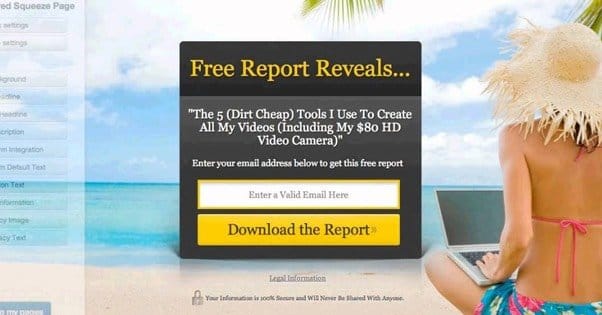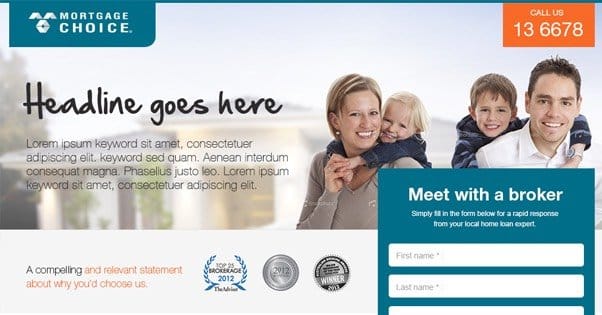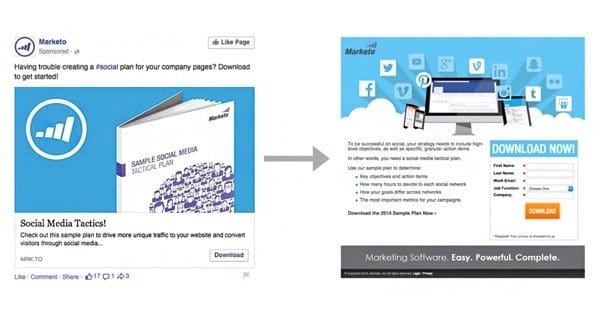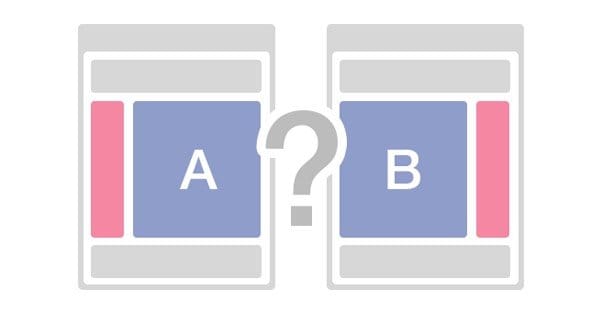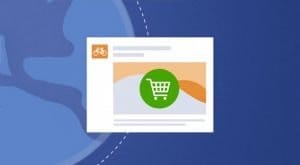 Written by ContentPowered.com
Written by ContentPowered.com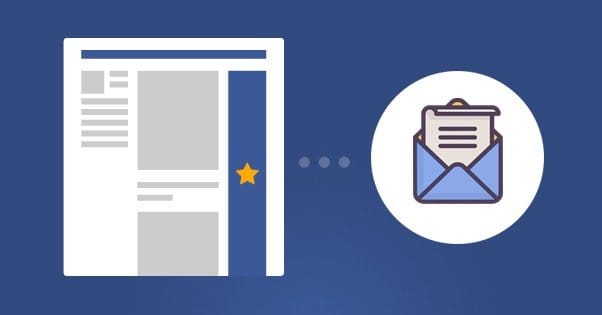
We’ve written about using social networks for lead generation before. One such post here, about Twitter, covers a lot of the organic techniques you can use on any site. This post is going to be focused differently. Rather than Twitter, we’re aiming at Facebook, the biggest social network in history. And, rather than focus on organic lead generation, we’re looking at Facebook ads.
About Lead Generation
Lead generation is the idea of drumming up customer interest to get them to investigate your product. It’s the broad, open mouth of the sales funnel, designed to pull people in to a point where you can lay on the higher pressure sales. It’s the outer edge of the whirlpool, drawing in the unsuspecting.
Good lead generation is filtered and targeted. Anyone can throw up a page and buy a few ads, but without proper targeting, all you’ll get are random people coming in. There are 7 billion people on this planet, and 1.5 billion of them use Facebook. How many of them are actually capable of buying your products or interested in using them? How many of those people are actually valuable to you? Good lead generation filters out the people who are of no use to you, and gives you a list of people who are qualified.
Good lead generation is cost efficient. There are dozens of ways to generate interest online. The problem with many of them is the cost. While you can optimize them, there are certain minimum thresholds you can’t go under without sacrificing the first point. With Facebook ads, you can get extremely cheap leads, though there is a minimum cost here as well.
Good lead generation does more than just generate leads, too. It helps build brand awareness and customer loyalty. By providing interesting content and value, you show people you’re a brand that knows what it’s talking about. You become a trusted brand, and that makes it easier to generate future leads and convert the leads you already have.
So, keep all of that in mind when you follow the steps throughout the rest of this post. You’re striving to optimize to generate cheap, qualified leads and build your brand image. However, don’t get too caught up in optimization. You’ll lose sight of the goal and waste time and money on perfecting what can never be truly perfect.
Step 1: Create a Lead Magnet
Magnets attract ferrous substances. A lead magnet attracts leads. Therefore, a lead magnet must be something that is attractive and valuable to your potential customers. It’s something you must be willing to offer in exchange for a lead, which is typically a short opt-in, a name and email.
If you immediately thought of an eBook, you’re thinking along the same lines as thousands of other marketers. There’s a reason for that; they work, they’re simple, and they’re relatively easy to create. The problem is, creating a good eBook can be more time consuming than the actual act of creation implies.
A good eBook tends to be anywhere from 20 to 50 pages of deep, detailed content. That’s a lot of work to research, outline, and cite to support. You need to write it, edit it, rewrite it, re-edit it, proofread it, enhance it with graphical content, and publish it. Then, and only then, do you find out if you picked a topic attractive enough to generate leads.
This is why many marketers are starting to opt for shorter, less bloated lead magnets. After all, value is in the eye of the beholder. If a user sees a 50 page eBook on offer, but they know they don’t have time to read something that large, they won’t do it. It’s not an effective lead magnet there. For that matter, it has no value unless a user is able to pull value from it. In that sense, it’s like a diamond; only as valuable as society deems it to be.
Here are some lead magnet ideas.
- eBooks. As mentioned, these take a lot of work to create, but they can be very valuable for a long time while you have them.
- Articles. Access to multiple shorter articles, or even one good detailed article, can be like an eBook-lite lead magnet. Potentially more valuable, even, if users get more out of it.
- Tools. Something like BuzzSumo or Twitonomy gives you access to useful features or data, and if you gate it behind a simple opt-in form, people will be happy to sign up just to use it.
- Checklists. Write a good, solid list of things to do before a project, and promote that checklist as a great reference. Make sure it’s complete, though.
- Templates. Excel sheets, PDFs, images; templates streamline the design and coding process for many tasks.
- Offers or discount. What better way to get people interested in buying your product than to offer them the product for a cheaper rate, in exchange for a short opt-in?
- Digital courses. This is something you can build out of repurposed content. One lengthy eBook can be broken up into five videos or 10 instructional emails, where users get all the same value, spread out over time and in a more easily digestible form.
Regardless of what you pick, make sure it fits your needs. It should be something that attracts a specific sub-set of users. It doesn’t need to reach out to your entire audience! That’s because you can have several different lead magnets at once. Try to make something that solves a problem and is perceived as valuable in doing so, rather than something that is idle curiosity or low value.
Step 2: Create a Landing Page
A landing page is the destination of your Facebook ads, and it’s where you’ll host your lead magnet. This page needs a few crucial elements to succeed.
- Your offer. Without your central offer, your lead magnet, you can’t get more than a small handful of leads who opt in based on past marketing.
- Your opt-in form. You need some way to collect information and distribute your lead magnet, right? That’s what this form is for.
- Copy. The copy that surrounds your offer and form is what helps convince users of the value of the offer, giving them a reason to fill in the form.
- Analytics. How else would you harvest data about your audience? Integrating Google Analytics – and the Facebook conversion pixel to the post-opt-in confirmation page – gives you the data you need to iterate and improve.
There are a ton of different ways to create a landing page. You can code one up yourself or pay a developer to do it, of course. You can also use various services, like Lead Pages, Unbounce, Instapage, OptimizePress, or Hubspot. All of these have different pros and cons, different price points, and different limits on their services.
A good landing page should minimize distractions. In general, there should be nothing on the page that isn’t focused on your offer and your call to action. No links to external pages, no footer, nothing that can drag people out of the page. It’s an end stop, a cul-de-sac on the internet.
A good opt-in form has as few fields to fill out as possible. The most basic form should have two; email address and name. That’s all you need to begin research and sales. Anything beyond that – company name, company size, position, ad spend, etc – depends on how much you think your lead magnet is worth. Every individual field is a piece of information a user might not want to give out, and thus a failed lead.
There’s a lot you can do to optimize a landing page. I mean a lot. No, more than that. Check out this guide to have some idea. I could spend the rest of this post and then some just going over those tips, by why should I? They’ve already done it.
Step 3: Send People to Your Landing Page
You have the lead magnet and the form it powers. You have the page that hosts it, and acts as the terminus for this stage of your sales funnel. Now you just need one more thing; a way to get people from their positions of comfort to your landing page.
The problem with landing pages is that they don’t have much of anything on them. Google, to look at it, would consider it a piece of thin content. They know what a landing page looks like and they aren’t going to penalize you for having one, but they also aren’t going to put your landing page in the search results. You’re not going to get much if any organic search traffic. So where does your traffic come from?
This is where Facebook and Facebook ads come in. The first thing you need to do is make sure your Facebook conversion tracking pixel is in place. It needs to be somewhere that triggers when the user has successfully converted, but isn’t accessible from other locations. Otherwise, your data is going to be skewed. I recommend a “thanks for subscribing, now claim your free offer” page. Your landing page is tapped out in value once the user has decided to opt in, so you don’t need to keep people on it with a form that refreshes itself. That’s useful for forms on blog posts, not on landing pages.
Now we need to talk about Facebook ads themselves. Ads come in many forms and many objectives, and the whole system can be pretty complicated.
For one thing, you have ad campaigns, ad sets, and individual ads. This is a hierarchal setup designed for testing ad variations. You might have a campaign that centers around your lead magnet, and that’s fine. In that campaign, you might have an ad set for sidebar ads, an ad set for news feed ads, and an ad set for mobile ads. That’s also fine. Within each ad set, you’ll have variations on the same ad; same copy with different image, same image with different headline, and so forth. This is also where variations in targeting come in.
Of course, this means you might end up juggling a lot of different ads. Try to avoid creating too many variations, because it will be expensive to run and test all of them. If you have three campaigns, each with three ad sets, each with four ads, you have 36 ads to pay for. With Facebook, remember, money directly correlates to traffic. You can do things to make each visitor cheaper, but you still get nothing if you don’t pay.
Good Facebook ads need to be compelling. Remember, it’s all about the user and the value – immediate value – they can take away from the interaction. They know that clicking an ad is clicking an ad. They know it’s something that will benefit you. You just need to convince them they’ll get more out of it than they put in. A good design, a sense of urgency, user-focused copy; there’s a lot to it.
- Target specific buyer personas. Just like your lead magnet is aimed at specific users, your ads need to be aimed at those users as well.
- Include a call to action. Passive ads don’t cut it when everyone wants something, and people are used to only doing what calls to them the most.
- Choose a stand-out image, with bonus points if you have a professional production that really clicks with your content.
- Keep your branding, imagery, copy, and offer all consistent. Not only does this smooth the transition between Facebook and landing page; it’s required by Facebook. If there’s too much disconnect, Facebook will degrade your content and charge you more.
There are a lot more tips, and you can read some of them here.
Arguably the most important part of your ad, beyond even the copy and design, will be the targeting. Ad targeting determines who sees your ads, and that needs to line up with the people you designed your lead magnet to reach. It doesn’t do you any good to bring the wrong kind of people to your landing page.
There are a ton of different targeting options on Facebook, so you can be very specific with your audience. However, don’t go overboard; the more specific targeting you ad, the more expensive each individual lead is going to be. You need to strike the right balance between too general to get targeted traffic, and too specific to get cheap traffic.
Targeting is also excellent as the focus of a series of tests. Who converts better for your offer; men or women? Younger or older users? People with high incomes or low? People interested in such and such a topic? Using ad relevance, as computed by Facebook, will help you determine the ideal targeting.
At the end of the day, your “ideal” audience should be in the 500,000 to 1,000,000 person range. Don’t worry; you won’t be reaching nearly that many people, because you’re limited in your budget. That, and because many of them might not actively use Facebook.
Once you reach an audience of sufficient size on Facebook, you can run ads specifically targeting them, but that’s another story. Those won’t be ads designed for lead generation; they’ll be sales ads.
At this point, figure out how much your budget can sustain in terms of traffic, and test to optimize your ads. You have everything you need in place; just run them and measure them. The data will tell you what you need to do to maximize your opt-in rates.

